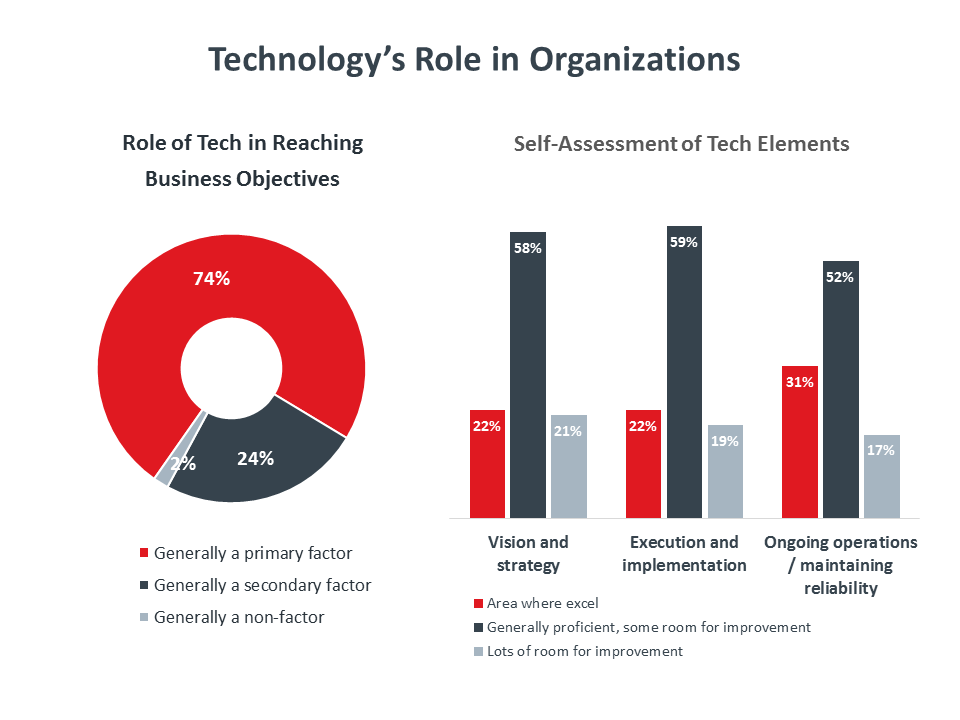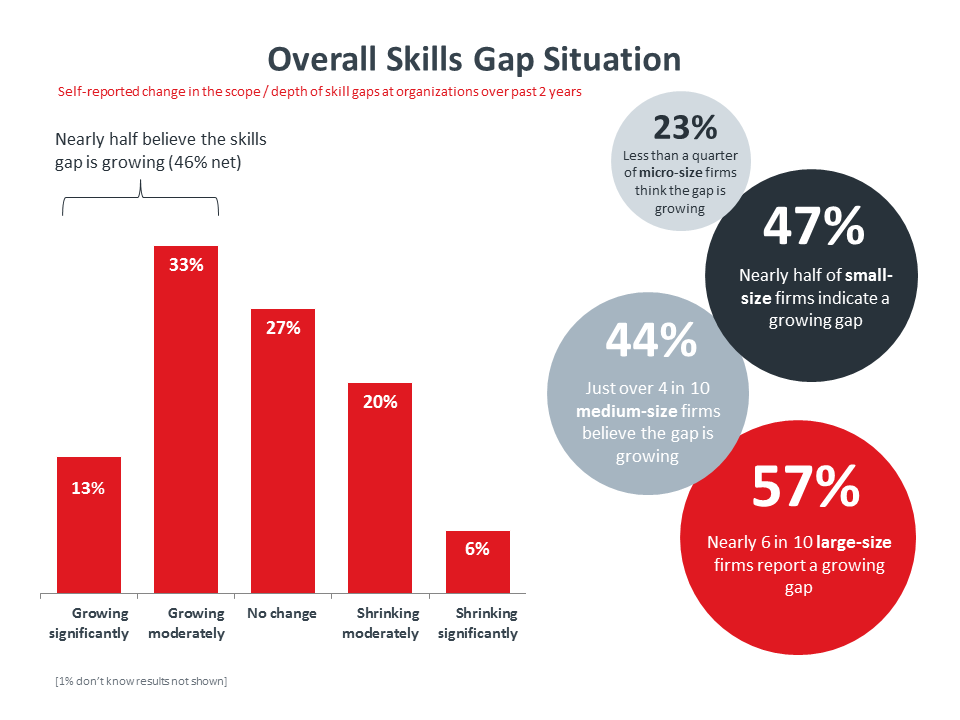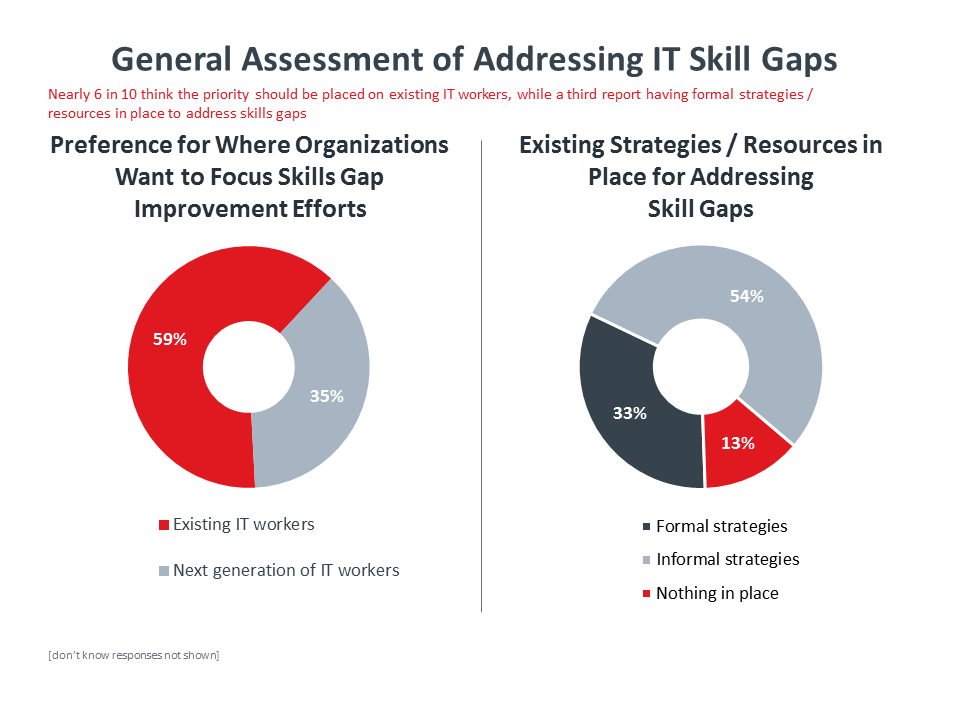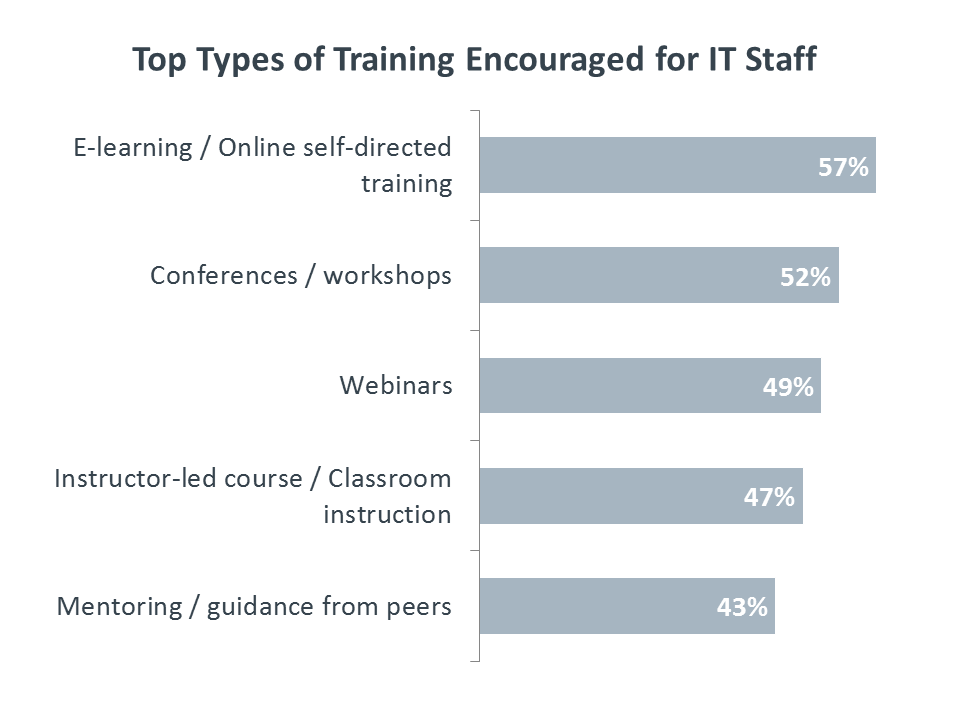G iven the breadth and pace of innovation, all signs point to a widening skills gap. This will put further pressure on organizations of all sizes to rethink their workforce strategies. While the notion of a skills gap is a seemingly straightforward concept, below the surface, there are many nuances to the story. This CompTIA research report explores these issues, setting the stage for approaches to tackling the IT skills gap.
Skills gap has become somewhat of a catch-all term to describe a range of workforce concerns
At the most basic level, skills gap can be characterized as the variance between the performance
employers desire from their workforce and what workers can or choose to deliver. Things get murky when skills gap discussions venture into other workforce challenges, such as labor supply gap, pipeline gap, pay gap, location gap, or generational
gap. For example, what may be thought of as a skills gap by an employer may in fact be a difference in millennial work styles. Furthermore, the skills gap and related issues are not limited to information technology (IT) occupations. Organizations
report varying degrees of skills gaps across business functions.
Despite the consequences, most organizations do not have a formal strategy to address skills gaps
Organizations report a number of consequences attributed to skills gaps, from lower staff
productivity and sales, to deficiencies with innovation and new product development. Despite the negative impact to the bottom line, only 1 in 3 organizations indicate they have a formal process and resources in place to address skills gap
challenges. The remaining two-thirds of respondents report having only an informal process or no process at all in place. Compounding this lack of focus, more than half of organizations (54%) acknowledge they struggle to some degree in identifying
and assessing skills gaps among their workforce. Obviously, knowing what to fix must precede discussions of how to fix it.
The cybersecurity skills gap is especially problematic
In a world defined by digitization and interconnectivity, shortcomings in cybersecurity expertise and experience make for an ever-more
precarious situation. Organizations rank data security as the most pressing cybersecurity skills gap domain, reflecting the growing importance of data across every industry sector of the economy.
The multifaceted nature of skills gaps require an equally diverse set of solutions
Is a persistent skills gap the new normal, or can meaningful steps be taken to mitigate the problem?
Looking ahead five or 10 years, what will the skills gap landscape look like? While there are no easy answers, it is certain that without efforts on multiple fronts, the outlook for progress is bleak.
For the most part, IT and business executives agree that technology plays a notable role overall in attaining their organization’s strategic objectives. Technology is generally a primary factor in reaching business objectives for nearly three-quarters of organizations (74%), while 24% indicate it plays more of a secondary factor. Only 2% cite technology as being a non-factor. However, with 9 million SMBs in the US alone, consider how much gains in productivity, innovation, revenue, etc. may be realized if these firms took greater advantage of technology, or even if the 24% stepped it up a notch so that it typically has a primary vs. secondary seat. Understandably, there are many competing factors at play when running a business. But those who already consider technology to be a primary factor are more likely to work in an IT business, have at least 10 employees, be an IT executive/manager, or are younger than 45 years of age.
Implementing new systems or work processes to enhance efficiencies is a top business priority for more than half of organizations (55%). And while it’s the top priority for firms with 10 or more employees (not even making the top five among micro-size companies), it ranks number one for two-thirds of large-size firms (67% of organizations with 500 or more employees). It also ranks of higher priority among IT executives/managers (61%) compared to other executives and business managers. Hiring skilled workers to drive strategic goals is another top priority among companies with at least 10 employees. Furthermore, it is number two for the large-size firms.
The role of technology is not a separate matter from people of course. The two go hand-in-hand, needing each other to reach higher levels of success than either could single-handedly. And with the evolving nature of IT, so is the nature of tech skills.

As with most things, there is always room for improvement and technology is certainly no exception. When IT and business executives rate their organization in certain areas of technology, over half rate it as generally proficient but with some room for improvement (mainly for the area of ‘execution and implementation’), about 1 in 4 indicate lots of room for improvement (particularly for ‘vision and strategy’), and the remainder rating it as an area where they excel (especially for ongoing operations / maintaining reliability).
When it comes to the concept of a workforce “skills gap,” most IT and business executives recall hearing or seeing something about it (86% definitely or maybe), regardless of job role. However, it is a more prevalent concept within IT companies vs. organizations outside the IT industry, as well as among those who view technology as a primary factor in reaching business objectives.

Nearly half report that the skills gap situation at their organization has grown in scope / depth over the past two years (46% significant + moderate growth). Interestingly, executives and business managers report significant growth in skills gaps at a greater rate than their IT executive / manager counterparts. Perhaps less surprisingly, IT businesses or organizations with 15 or more IT employees are also more likely to see significant growth in skills gaps.

As technology evolves, so does the need for business and employees of all types to keep up. Gaps in skills not only hold a business back from achieving further success, but negative impacts also are seen in key business areas by 94% of organizations. Consider that more than half of businesses report lower staff productivity due to skills gaps, or that one-third have lower sales or profitability due to gaps in skills.

Skills gaps are not analogous to IT alone. In fact, when skill gaps / levels of proficiency are compared across six business functions, IT still ranks in the top three, but a greater level of gaps are reported with marketing and sales / business development. Gap / proficiency ratings for IT rate similarly to operations. And in comparison, skill gaps are less of an issue among customer service and accounting / finance functions.
Delving further into the IT skills gap, 8 in 10 IT and business executives are at least somewhat concerned with the IT skills gap at their organization. One-quarter are very concerned (25%). Who is significantly more concerned about the IT skills gap?
There are many other possible influences beyond work performance and tech changes that may play into IT skills gap concerns. Managers may use the skills gap discussion as a catchall for workplace challenges that are more so a factor of labor market dynamics or even personal experiences or beliefs.
An accurate evaluation of the IT skills gap is more difficult when fewer than half of organizations report having a good handle on identifying and assessing skills gaps themselves (44%). The 27% who often struggle are more likely to be outside the IT industry (e.g. professional services, education, manufacturing, healthcare / medical, financial / banking / insurance), IT or business managers (vs. executives), have 1-4 IT employees, or are younger than 45 years of age. Conversely, those who feel like they have a good handle on it are more likely to be in the IT industry, executives, have 15 or more IT employees, or are in the 30-34 years age range. Another 27% are in-between the two end points, with a pretty good handle on some roles and skills, but struggle with identifying and assessing gaps in other roles.

Regardless of the measurement of skills gaps, perceptions are real nonetheless. The top impression shared by most IT and business executives is that too many workers lack advanced skills. Fortunately, this is a relatively easier, more tangible area to address via improved training efforts focused on specialized topics. Already, nearly all organizations provide at least some support for professional development, training, or continuing education for their IT workers to keep up to date with their skills, albeit mostly at an informal-strategy level. Still, more employer support is needed and would be welcomed as IT professionals already have a penchant for continued learning and desire additional training resources.

Cybersecurity skills gap concerns manifest themselves in two ways. The first way is the direct referencing of expertise or experience shortcomings that pertain to some aspect of cybersecurity. The top skills gap mentions include: data security, traditional security safeguards such as firewalls and antivirus software, and cloud security.

The second way is indirectly through practices or pursuits that inevitably have a cybersecurity component. For example, 6 in 10 organizations report skills gap challenges that inhibit the integration of different applications, data sources, platforms, or devices. This is a critical step for organizations seeking to modernize through business transformation. While cybersecurity is not specifically mentioned, it is an implied requirement.
Similarly, organizations testing the waters with IoT, artificial intelligence, or robotics, for example, face skills gaps due to the emerging and fluid essence of these technologies. It takes time for training material and opportunities for workers to gain experience to catch up. As described above, security best practices, and the corresponding skill sets, must be a priority from the onset.

When given the choice between focusing skills gap improvement efforts on existing IT workers or the next generation of IT workers, a majority of survey respondents preferred to focus on existing workers. This speaks to short-term self-interests, which makes sense given the segment of organizations struggling to keep up with skills gap challenges.
However, with nearly 800,000 looming IT worker retirements through 2024 (according to a CompTIA analysis of EMSI and BLS data), delaying efforts to address the quantity and quality of the talent pipeline will only exacerbate the problem.
Among possible strategies cited for addressing skills gap challenges among the IT workforce pipeline, respondents emphasized the need for better approaches to enable candidates to gain relevant work experience and on-the-job training. Although the practice of apprenticeships has been around for hundreds of years, there has been renewed interest of late in applying the concept to fields not traditionally associated with apprenticeships, such as IT. The research confirms this assertion with about half of respondents indicating the concept of apprenticeships for IT occupations definitely has merit, while 39% indicate it probably has merit.

This quantitative study consisted of an online survey fielded to IT and business executives during February 2017. A total of 600 professionals based in the United States participated in the survey, yielding an overall margin of sampling error proxy at 95% confidence of +/- 4.0 percentage points. Sampling error is larger for subgroups of the data.
As with any survey, sampling error is only one source of possible error. While non-sampling error cannot be accurately calculated, precautionary steps were taken in all phases of the survey design, collection and processing of the data to minimize its influence.
CompTIA is responsible for all content and analysis. Any questions regarding the study should be directed to CompTIA Research and Market Intelligence staff at research@comptia.org.
CompTIA is a member of the market research industry’s Insights Association and adheres to its internationally respected Code of Standards.
Read more about IT Workforce.
Tags : IT Workforce